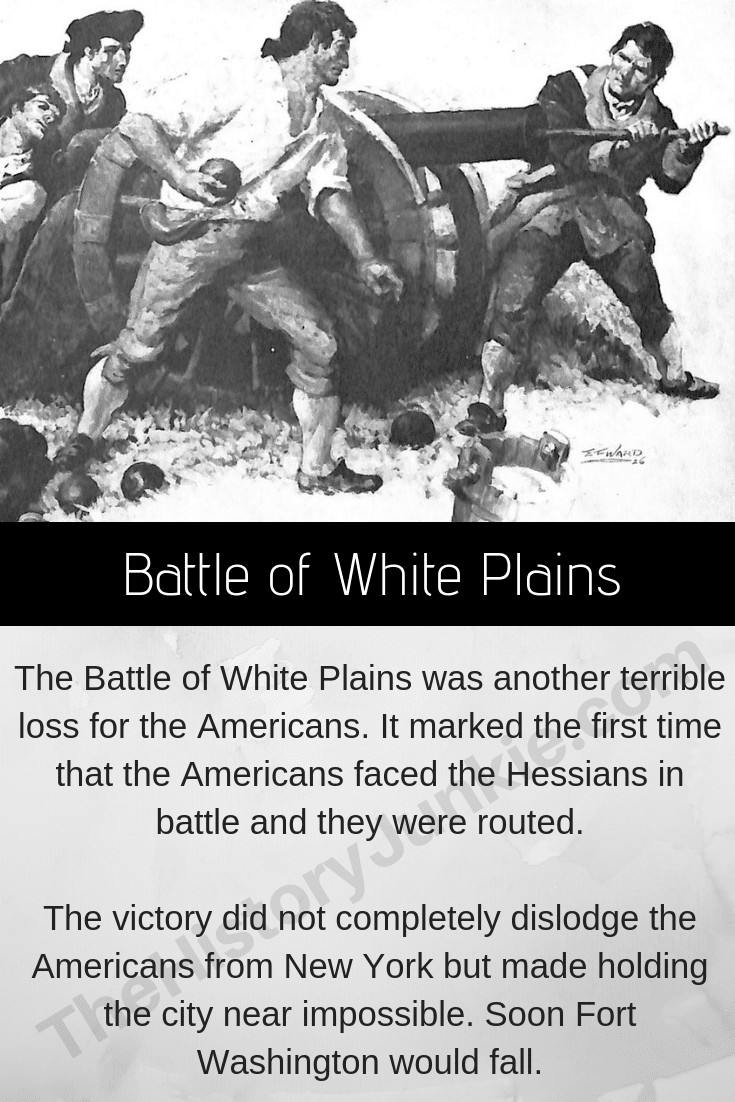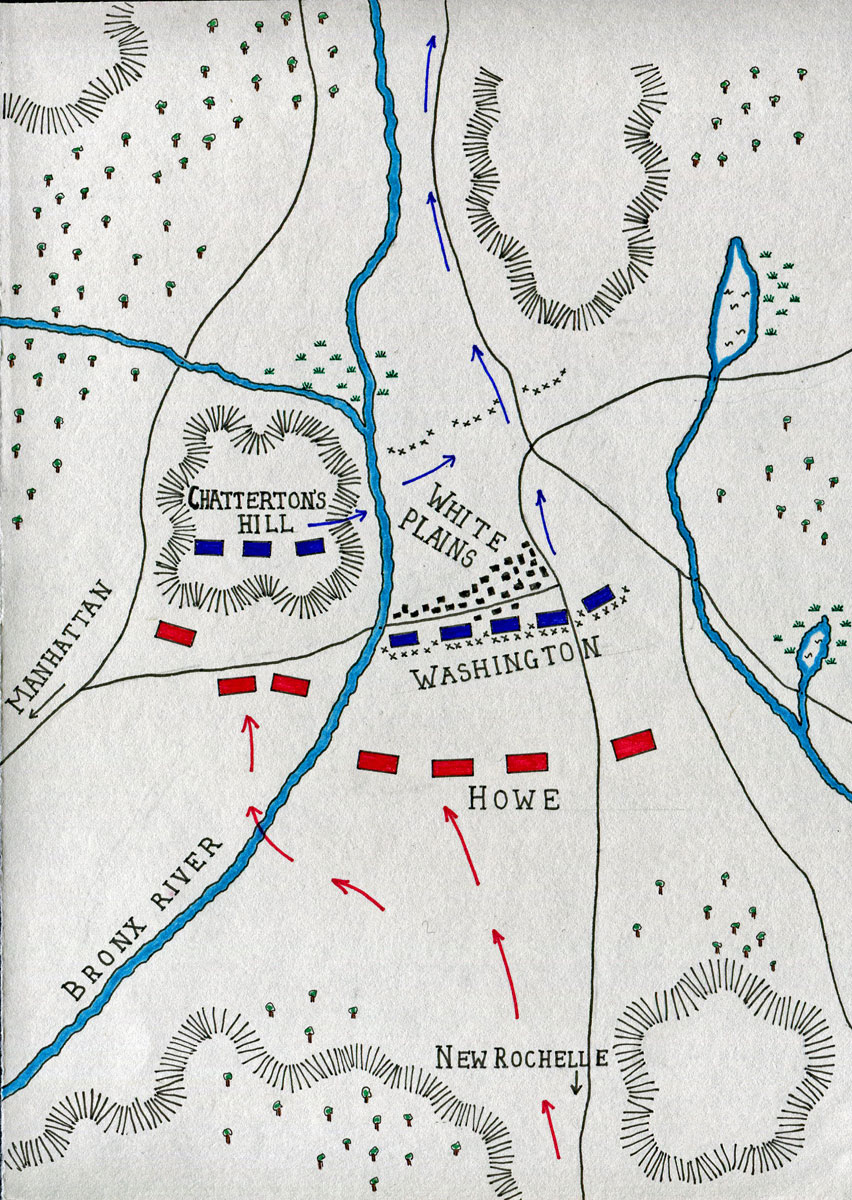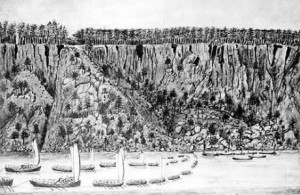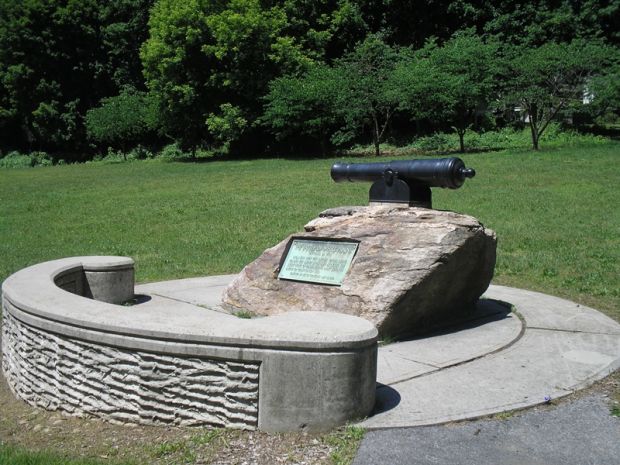Just before the Battle of White Plains, the British had pushed the Continental Army off of the coast of Manhattan. Howe cautiously moved his army into place, and instead of attacking a devastated and ill-equipped Continental Army quickly, he paralleled George Washington.

Howe extended his army and found Washington's army deployed west of his own men. He aimed to trap Washington and his men, and to do so, he launched a surprise amphibious assault with 4,000 men at Pell's Point.
However, the Continentals were not caught off-guard and defended fiercely, successfully pushing the British back.
Howe then moved his army northward to a village called Scarsdale. Here, his reconnaissance revealed that Washington's army was nearby, protecting his right flank. Howe wasted no time and engaged the Continental Army.
General George Washington's Preparations
General Washington had spent most of his time retreating. After the Continental Army had been pushed off of Manhattan Island, Washington deployed his army in a long defensive line to avoid being encircled by the British.
This allowed him to evacuate local supplies before they could be captured. He also left about 1,500 men behind at Fort Washington and another 3,500 men at Fort Lee, all of which were under the command of General Nathanael Greene.
Washington also placed obstacles in the river to stop or at least slow the British Navy from moving down the river. After organizing this defense, it left Washington about 14,500 men to deal with Howe.
This plan was extremely risky because he was dividing an inferior force in front of a superior army. It left his demoralized and ill-equipped lines overextended and susceptible to quick attacks. However, Howe was cautious and did not exploit it.
On October 18, the Continentals successfully defended against an amphibious attack. 4,000 Hessian troops engaged the American defense in a day-long fight that ended with them retreating and Howe moving his army farther north.
Although the victory held Washington's overextended line, it had little effect on Howe. Howe marched further north to expose Washington's line. The two armies skirmished around the Scarsdale area for a few days until Washington moved his army to the White Plains.
Howe, learning where Washington was concentrating his army, wasted little time engaging him. The Battle of White Plains began shortly after.
Battle of White Plains Begins

At around 10:00 a.m. during the Battle of White Plains, General William Howe gave the order to advance his army in two columns. One of these columns would be British, and the other column would be Hessian.
The commander of the British column was Sir Henry Clinton, and the commander of the Hessian column was General von Heister. Washington then ordered General Joseph Spencer and about 1,500 men to try to halt the two British columns. Spencer's men fought well but were simply outclassed by a much more experienced and well-trained army.
Spencer and his men fought hard while delivering steady fire and falling back from one stone wall to the next. However, when the Hessians under Johann Gottleib Rahl (The Hessian commander at the Battle of Trenton) attacked the left flank, the Americans were driven back.

Washington then made a quick adjustment. He ordered 1,600 Delaware and Maryland militiamen to the high ground to strengthen it. In total, there were about 2,500 men stationed on the high ground.
Washington's adjustment would not influence the Battle of White Plains. Howe moved his 13,000 men into the flat land below.
He then split up his command, separated eight regiments, and prepared for an all-out assault on the high ground.
To soften the American position up, Howe brought out twenty pieces of artillery and began firing on the American position. The artillery fire smothered the Americans, who only had two small artillery pieces.
Under the cloud of war, British and Hessian troops maneuvered to the Bronx River. Here, they met some stiff resistance but passed with little problem.
The British column then tried to directly attack the American position but found it extremely difficult and took heavy casualties in the process, and they fell back.
The Hessian column attempted to flank the Americans on the right and was met with heavy fire and suffered losses. It seemed as though the Battle of White Plains would share some similarities to the Battle of Bunker Hill.
However, the similarities would stop there when Colonel Rahl took a position on General Alexander McDougall's left flank and assaulted it. McDougall's left flank was exposed and was held by the inexperienced militia.
The fight was over quickly, and the American's crumbled in the face of Rahl's Hessians and British Calvary. The men fled. Some escaped, but many were killed, wounded, or captured.
The collapse of the left flank caused a domino effect in the American line. It exposed the flank of the Delaware troops, who were then thrown into confusion.
Many companies formed and were able to repel the attacking British and Hessian columns for a short period. However, the British were just too much, and the remnants of the Delaware regiment withdrew.
Howe commanded his troops to stop upon reaching Chatterton's hill. He now commanded the high ground, yet once again was unable to crush the ragtag colonials. Howe planned on attacking Washington again on October 31st but was unable to do so due to the weather.
On the morning of November 1st, Washington and his men were gone. Howe then stayed at White Plains for a few days and returned to New York City. This allowed Washington to retreat to New Jersey to fight another day.
Battle of White Plains Outcome and Casualties

The Battle of White Plains was a small affair. The victory drove Washington out of New York, and the fall of Fort Washington sometime later pushed the Americans completely out of New York.
However, the capture and control of New York City, which was perceived to be the most important city in the colonies, did little to squash the rebellion.
The British continued to fight the American Revolutionary War as if it were a European War in which an army conquered and occupied cities.
The American Revolution was different.
In order to defeat the Americans, the British had to destroy Washington's Army. The best chances of this came at the Battle of White Plains under Howe. After that, the British never came close again.
Howe's caution allowed Washington to escape into New Jersey. The losses sustained by the Americans in New York caused many to question the leadership of George Washington.
The Continental Army was in shambles. Deserters were increasing each day, and many enlistments were up at the end of the year. Washington knew he must make a daring move and bring the fight to the British.
He needed a victory to boost morale and secure his spot as Commander-in-chief of the Continental Army. That victory came shortly after his defeat. The Battle of Trenton and the Battle of Princeton would be considered one of Washington's finest moments as General.
